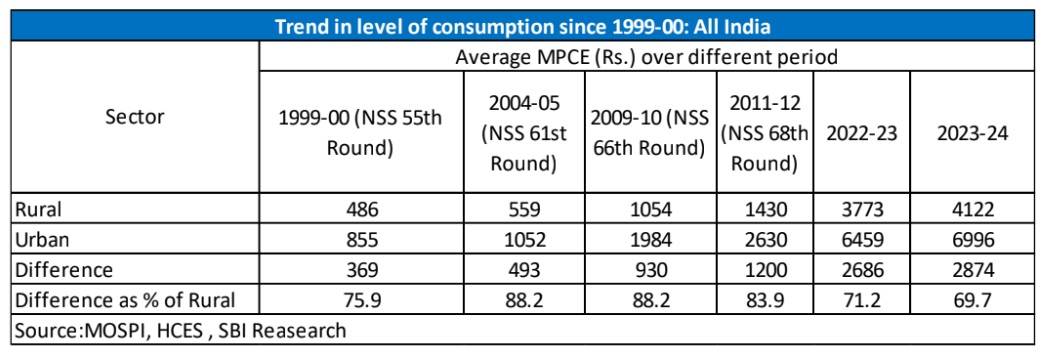Urban rural gap has declined from 88.2% in 2004-05 to 69.7% in 2023-24

FinTech BizNews Service
Mumbai, 2 January, 2025: Research Report from the Economic Department of State Bank of India titled – Consumption Expenditure Survey reveals a remarkable decline in Rural Poverty estimated at 4.86% in FY24.
Consumption Expenditure Survey reveals a remarkable decline in Rural Poverty estimated at 4.86% in FY24 (7.2% in FY23 and 25.7% in FY12)... Urban Poverty estimated at 4.09% (4.6% in FY23 & 13.7% in 2011-12)....overall poverty levels now in 4-4.5%.... The sharp decline in rural poverty ratio is on account of higher consumption growth in lowest 0-5% decile with significant Government support and such support is important as we also find that change in food prices has significant impact on not just food expenditures, but overall expenditure in general....the new weights drives down headline inflation by as much as 50 basis points in Nov’2024...
Based on 2023-24 fractile distribution, the sample proportion for poverty in rural areas is 4.86% and 4.09% in urban areas in FY24...This is significantly lower than FY23 estimates of rural poverty at 7.2% and urban poverty at 4.6%...
❑ It is possible that these numbers could undergo minor revisions once the 2021 census is completed and new Rural Urban population share is published. We believe Urban poverty could decline even further . At an aggregate level, we believe poverty rates in India could now be in the range of 4%-4.5% with almost minimal existence of extreme poverty
❑ Enhanced physical infrastructure is scripting a new story in Rural Mobility...one of the reasons for the increasingly shrinking
horizontal income gap between Rural and Urban and the vertical income gap within Rural Income classes
❑ The difference between rural and urban monthly per capita consumption expenditure/MPCE to rural MPCE is now at 69.7%, a rapid decline from 88.2% in 2009-10...mostly due to the initiatives the Government has taken in terms of DBT transfers, building Rural infrastructures, augmenting farmer’s income, improving the rural livelihood significantly
❑ We estimate that food inflation dampens consumption demand more in lower income states as compared to higher-income states, reflecting that rural people are comparatively more risk-averse in low-income states, than in high-income states
❑ We estimate that Nov’24 inflation because of the new weights would be 5.0% against 5.5%...
❑ Most of the high-income states delineate a savings rate greater than National Average (31%). Uttar Pradesh and Bihar show low savings rate possibly due to higher outward migration
Remarkably, states that were once considered laggards are showing the maximum improvement in
Rural and Urban Gap...States like Bihar, Rajasthan, etc. are showing increasingly the impact of
factors that are endogenous to the Rural Ecosystem....
The difference between rural and urban monthly per capita consumption expenditure/MPCE to rural MPCE is declining for all states
across income categories
❑ Our analysis reveals that the gap has been comparatively lower for middle income states and is further declining steeply